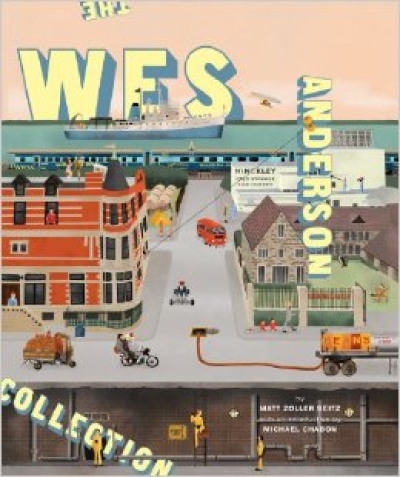
The Wes Anderson Collection
Wes Anderson is one of the most influential voices from the past two decades of American cinema. A true auteur, Anderson is known for the visual artistry, inimitable tone, and idiosyncratic characterizations that make each of his films—Bottle Rocket, Rushmore, The Royal Tenenbaums, The Life Aquatic with Steve Zissou, The Darjeeling Limited, Fantastic Mr. Fox, and Moonrise Kingdom—instantly recognizable as “Andersonian.” The Wes Anderson Collection is the first in-depth overview of Anderson’s filmography, guiding readers through his life and career. Previously unpublished photos, artwork, and ephemera complement a book-length conversation between Anderson and award-winning critic Matt Zoller Seitz. The interview and images are woven together in a meticulously designed book that captures the spirit of his films: melancholy and playful, wise and childish—and thoroughly original.
From Bookforum
Max Dalton's charming children's book-style illustrations introduce each film with a double-page spread of the movie's principal location, incorporating "fourth wall" views suggested by Anderson's familiar cutaway dollhouse technique, used so well in the opening of Moonrise Kingdom and The Life Aquatic. Designer Martin Venzky unpacks the filmmaker's sources and style—with an inspired deployment of stills, amusingly corny display type, and inventive layouts with images made to resemble postage stamps, scrapbook clippings, and other collectibles—perfectly capturing Anderson's seductively twee combination of obsessive detail and ironic distance. —Christopher Lyon
About the Author
Matt Zoller Seitz, a Pulitzer Prize finalist for criticism, currently writes for New York magazine. He lives in Brooklyn. Michael Chabon is the Pulitzer Prize–winning author of many novels, the most recent being Telegraph Avenue. He lives in Berkeley, California, with his wife and four children.
Praise for The Wes Anderson Collection:
“In The Wes Anderson Collection, Seitz expands a series of video essays on Anderson’s influences, illuminating as much of Anderson’s process as possible in a massive, beautifully rendered volume. Although it looks (and sometimes reads) like a coffee table book, The Wes Anderson Collection brings together style and substance to provide a loving homage to Anderson’s films and moviemaking in general.” —The A.V. Club
“Your coffee table wants—no, scratch that—needs this book . . . Packed with 400 images of everything from behind-the-scenes set shots to makeup inspiration to hand-drawn storyboards, the massive tome is pure eye candy. But in addition to the visuals, Seitz also dives deep into each and every Anderson film.” —NYLON
“A magical tour of Wes Anderson’s filmography.” —C magazine
“Each page of this book—filled with conversations, photographs and artwork surrounding each film—showcases Anderson’s pop-culture inspirations from Hitchcock and Star Wars to Jacques Cousteau and the French New Wave. Better than most of their kind, the talks reveal a candidness and honesty between critic and director, allowing Seitz to dig around Anderson’s vault and share his discoveries.” —FILTER
“The Wes Anderson Collection comes as close as a book can to reading like a Wes Anderson film. The design is meticulously crafted, with gorgeous full-page photos and touches like a still representation of Rushmore’s opening montage.” —The A.V. Club
“Reading the book, you feel as if you’re disappearing into the miniature world of Anderson’s movies, like you’re playing around in the files and fastidiously kept dossiers assembled for each project. In this way, the book mimics the work.” —Complex.com
“It’s smart, informative, and looks beautiful. In other words, it’s the perfect gift.” —Complex magazine

































































































